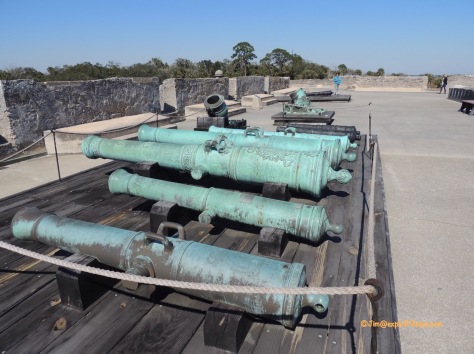In northeast Florida lies the oldest continually occupied settlement in the United States, St. Augustine. Founded in 1565 by Spain, this charming place has amassed a fair amount of history in the past 450 years. Diana and I decided to check out this interesting community on February 10.
We had dinner at Harry’s Seafood, a suggestion that our friends Rod and Mary had given us. The food was good and we enjoyed the New Orleans ambiance.

The restaurant is directly across the street from the waterfront.

They have a charming outdoor patio with heaters; had it been a touch warmer, we would have eaten out there.
We spent the night at the Doubletree by Hilton, which we found to be a very nice hotel. The staff went out of their way to be helpful, and our room was immaculate. A special shout-out to our breakfast server Bill, who was very attentive and friendly.
After breakfast, we crossed the street and visited the Shrine of Our Lady of La Leche. This 208 foot cross, the tallest in the world, marks the spot where Christianity was first proclaimed in what is now the United States. The museum was interesting and the grounds were pretty.
The centerpiece of St. Augustine is the Spanish fort, Castillo de San Marcos. The first version of the current masonry fort was constructed over 23 years, between 1672 and 1695. There were many additions and improvements since then. The key to the success of this fort is the unique masonry used in its construction; a locally quarried conglomerate known as coquina. Translated in Spanish, the name means ‘small shells’….and that is exactly what it is….blocks of small sea shells bonded together over millienia.
Just using what they had on hand, the Spanish didn’t find out until the fort came under siege by the British in 1740 just how good the coquina was. For two months, the British showered the fort with cannonballs, only to have them bounce off the walls. It turns out the air pockets in the coquina acted like shock absorbers, and the cannon fire only resulted in small dents in the surface. Eventually the British were trapped by Spanish reinforcements sent up from Havana, resulting in the Brits burning their ships and retreating to Carolina on foot.
This is an interpretive talk being given by a National Park ranger, explaining coquina’s superior properties to us. On the wall behind her, what appears to be a second story is actually the upper window of each room. Every one of the chambers are constructed with arched ceilings, which support the weight of the deck and cannons above.
This photo shows the arched ceilings. The legendary Seminole chief Osceola was held in this room in 1837, prior to being sent to Fort Moultrie in South Carolina where he died of what is believed to have been malaria.
The view of the harbor from the upper deck is breathtaking, to say the least!
Here is a selection of several of the different types of cannons used over the years by the various occupying armies. The fort changed hands six times: Spain (1672-1763), Great Britian (1763-1784), Spain (1784-1821), United States of America (1821-1861), Confederate States of America (1861-1862), and finally the United States of America (1862 – present).
We thoroughly enjoyed exploring the fort, and we will surely visit again in the future.
After the fort, we walked up St. George Street. There are many restaurants and shops along this pedestrian only road. At the southern end, we visited the Cathedral Basilica of St Augustine.
This building is an amazing example of Mediterranean archtecture.
The interior was gorgeous with its Spanish influence.
I especially liked the way the stained glass windows were framed. 🙂
There are many more places we didn’t have time to visit. We will be sure to check them out when we return to the area. With that being said, we are heading out from Melbourne Beach. We will be more mobile and less stationary for the next two months. Stay tuned as we reveal our destinations as we go!
———————————————————-
Search and shop Amazon.com here for just about anything imaginable.
explorRVistas is a participant in the Amazon Services LLC Associates Program, an affiliate advertising program designed to provide a means for sites to earn advertising fees by advertising and linking to Amazon .com. Shopping here doesn’t add anything to your cost, but it does help support this blog. Thank you for considering shopping through exploRVistas!












